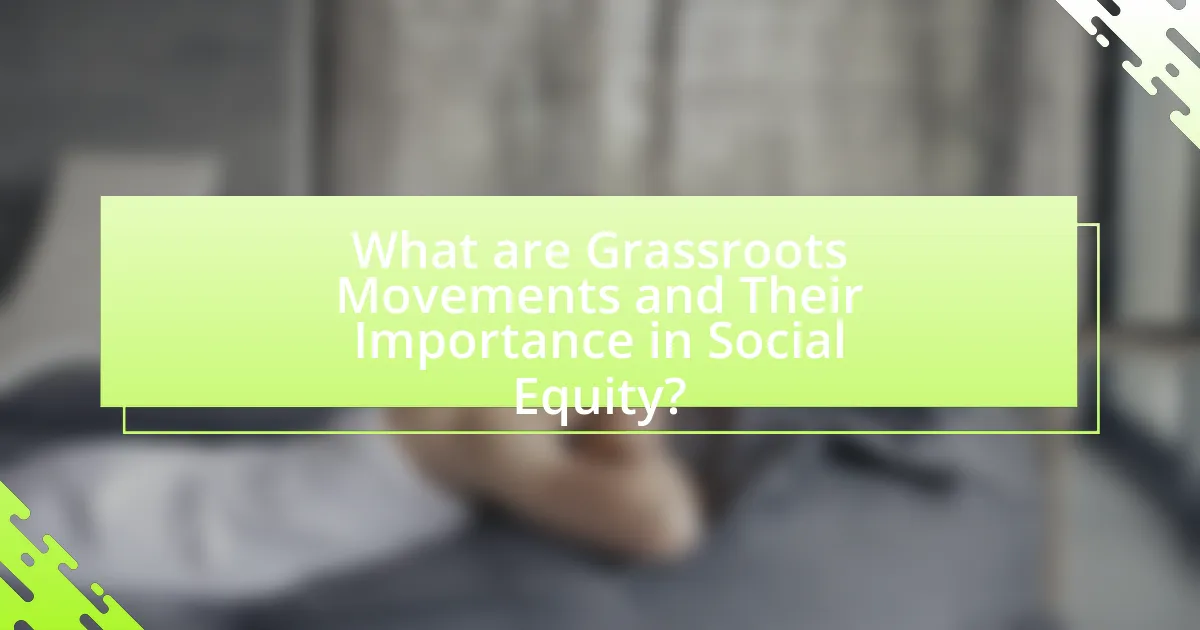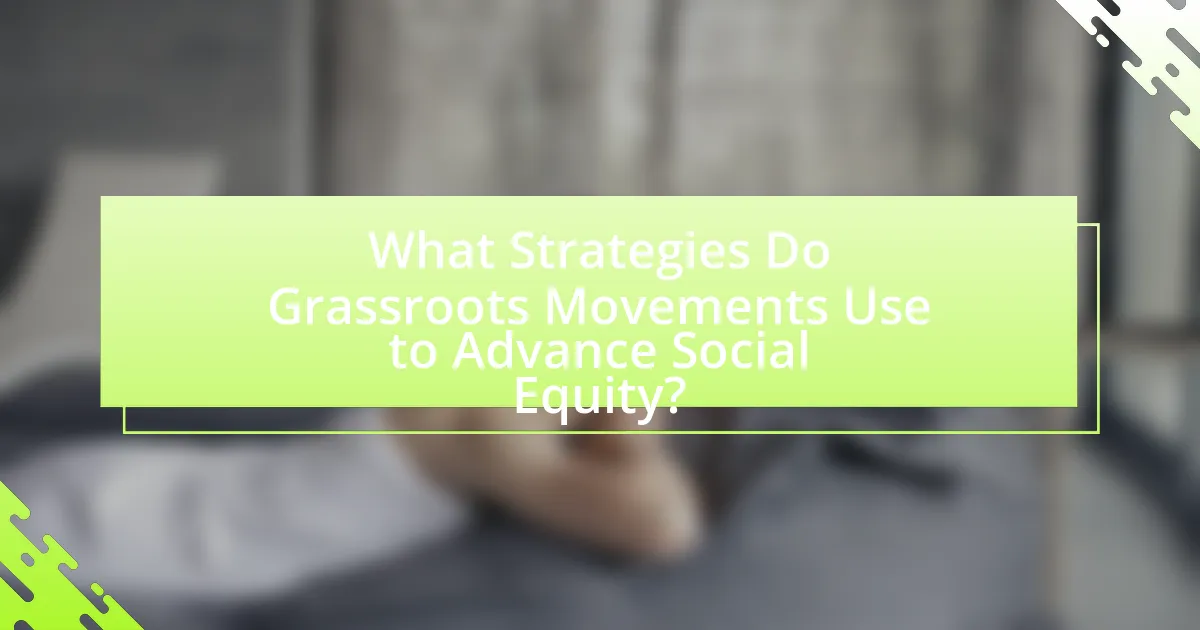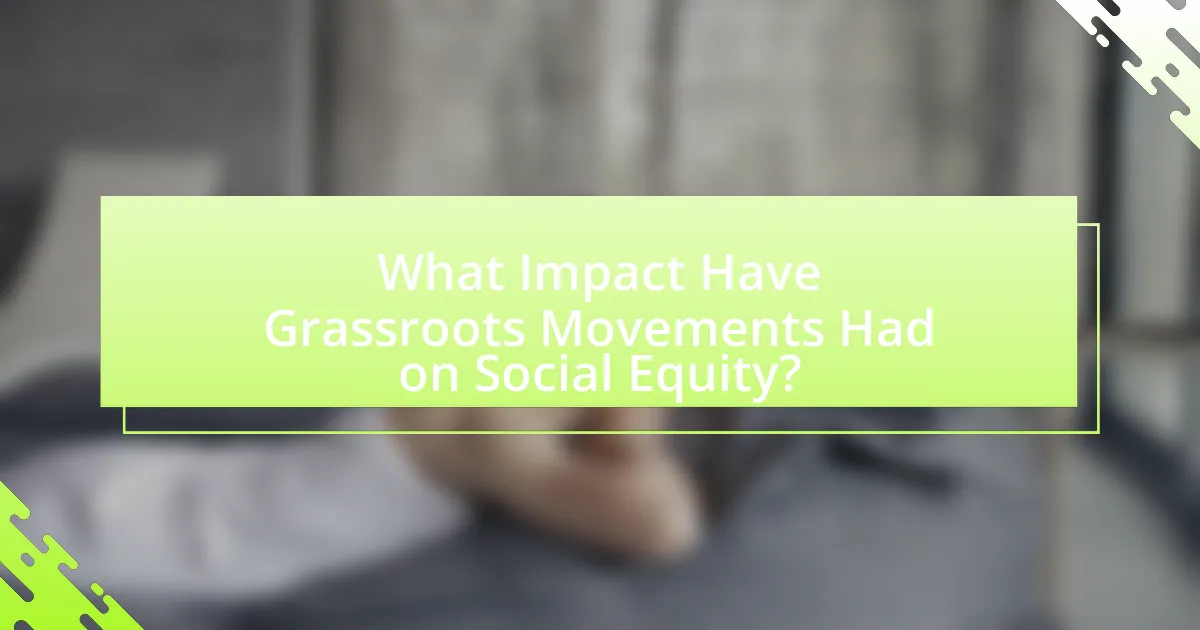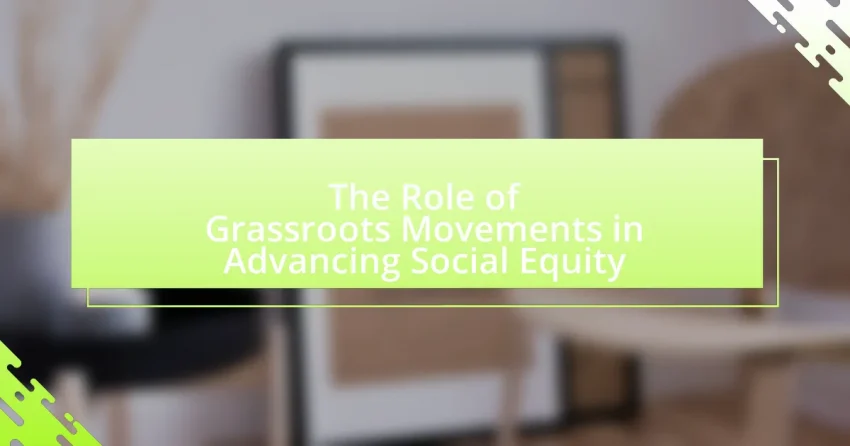Grassroots movements are collective actions initiated by ordinary individuals at the community level aimed at addressing social issues and advocating for change. These movements play a vital role in promoting social equity by empowering marginalized groups, amplifying their voices, and mobilizing resources to challenge systemic inequalities. The article explores how grassroots movements contribute to social equity through community engagement, effective strategies, and coalition-building, while also addressing the challenges they face, such as funding limitations and resistance from established institutions. Notable examples, including the Civil Rights Movement and the Black Lives Matter movement, illustrate the significant impact grassroots initiatives have had on policy changes and social justice. Additionally, the article highlights ways individuals can support these movements to foster a more equitable society.

What are Grassroots Movements and Their Importance in Social Equity?
Grassroots movements are collective actions initiated by ordinary people at the community level to address social issues and advocate for change. These movements are crucial for social equity as they empower marginalized groups, amplify their voices, and mobilize resources to challenge systemic inequalities. For instance, the Civil Rights Movement in the United States, which emerged from grassroots organizing, successfully fought against racial discrimination and led to significant legislative changes, such as the Civil Rights Act of 1964. This demonstrates how grassroots movements can effectively influence policy and promote social justice, highlighting their importance in advancing social equity.
How do grassroots movements contribute to social equity?
Grassroots movements contribute to social equity by mobilizing communities to advocate for systemic change and address inequalities. These movements empower marginalized groups, enabling them to voice their concerns and influence policy decisions that affect their lives. For instance, the Civil Rights Movement in the United States, which was driven by grassroots activism, led to significant legislative changes such as the Civil Rights Act of 1964, which aimed to eliminate discrimination and promote equal rights. Additionally, grassroots organizations often provide essential services and support networks that help individuals access resources, thereby reducing disparities in education, healthcare, and economic opportunities.
What are the key characteristics of effective grassroots movements?
Effective grassroots movements are characterized by strong community engagement, clear goals, and inclusive participation. Community engagement fosters a sense of ownership and mobilizes individuals to take action, as seen in the Civil Rights Movement, where local leaders galvanized support through grassroots organizing. Clear goals provide direction and focus, enabling movements to articulate specific demands, such as the Fight for $15 campaign advocating for a $15 minimum wage. Inclusive participation ensures diverse voices are heard, enhancing legitimacy and broadening support; for instance, the Women’s March in 2017 united various groups advocating for women’s rights and social justice. These characteristics collectively empower grassroots movements to drive social change effectively.
How do grassroots movements mobilize communities for social change?
Grassroots movements mobilize communities for social change by fostering local engagement and empowering individuals to take collective action. These movements often utilize strategies such as community organizing, education, and advocacy to raise awareness about social issues and galvanize support. For instance, the Civil Rights Movement in the United States effectively mobilized communities through grassroots organizing, leading to significant legislative changes like the Civil Rights Act of 1964. By creating networks of support and encouraging participation, grassroots movements can amplify marginalized voices and drive systemic change.
Why are grassroots movements essential for marginalized communities?
Grassroots movements are essential for marginalized communities because they empower individuals to advocate for their rights and address systemic inequalities. These movements provide a platform for collective action, enabling marginalized groups to voice their concerns and influence policy changes. For instance, the Civil Rights Movement in the United States, which was largely grassroots-driven, led to significant legislative changes, such as the Civil Rights Act of 1964, which aimed to eliminate discrimination based on race. Additionally, grassroots movements often mobilize local resources and foster community solidarity, which is crucial for sustaining long-term social change.
What role do grassroots movements play in amplifying marginalized voices?
Grassroots movements play a crucial role in amplifying marginalized voices by providing a platform for individuals and communities to express their concerns and advocate for their rights. These movements often mobilize local populations, fostering community engagement and solidarity, which enhances visibility for issues that may otherwise be overlooked by mainstream media and political discourse. For instance, the Black Lives Matter movement has effectively highlighted systemic racism and police brutality, leading to widespread public awareness and policy discussions. Additionally, grassroots organizations often utilize social media to disseminate information rapidly, allowing marginalized groups to share their narratives and experiences directly with a broader audience, thereby challenging dominant narratives and fostering social change.
How do grassroots movements address systemic inequalities?
Grassroots movements address systemic inequalities by mobilizing communities to advocate for social, economic, and political change. These movements often focus on raising awareness about injustices, organizing collective action, and influencing policy decisions that perpetuate inequality. For example, the Civil Rights Movement in the United States effectively challenged racial segregation and discrimination through grassroots organizing, leading to significant legislative changes such as the Civil Rights Act of 1964. Additionally, grassroots movements utilize social media and community engagement to amplify marginalized voices, ensuring that those affected by systemic inequalities can participate in the dialogue and decision-making processes that impact their lives.

What Strategies Do Grassroots Movements Use to Advance Social Equity?
Grassroots movements use strategies such as community organizing, coalition building, advocacy, and public awareness campaigns to advance social equity. Community organizing involves mobilizing individuals to collectively address issues affecting their lives, fostering a sense of agency and empowerment. Coalition building brings together diverse groups to amplify voices and resources, enhancing the impact of their efforts. Advocacy efforts focus on influencing policy changes at local, state, or national levels, often supported by data and research that highlight social inequities. Public awareness campaigns utilize social media and traditional media to educate the broader public about social justice issues, aiming to shift public perception and garner support. For instance, the Black Lives Matter movement effectively employed these strategies to raise awareness about systemic racism and police violence, leading to significant policy discussions and reforms in various jurisdictions.
How do grassroots movements organize and mobilize supporters?
Grassroots movements organize and mobilize supporters through community engagement, strategic communication, and coalition-building. These movements often begin by identifying shared concerns within a community, which fosters a sense of collective identity and purpose. They utilize social media platforms and local events to disseminate information, rally support, and encourage participation. For example, the Black Lives Matter movement effectively used social media to mobilize protests and raise awareness about racial injustice, demonstrating the power of digital communication in grassroots organizing. Additionally, grassroots movements often collaborate with local organizations and leaders to amplify their reach and resources, creating a network of support that enhances their impact. This approach not only builds a strong base of committed supporters but also ensures that the movement remains responsive to the needs and voices of the community it represents.
What tools and platforms do grassroots movements utilize for outreach?
Grassroots movements utilize social media platforms, email campaigns, community organizing tools, and crowdfunding websites for outreach. Social media platforms like Facebook, Twitter, and Instagram enable these movements to reach a broad audience quickly, facilitating engagement and mobilization. Email campaigns allow for targeted communication, keeping supporters informed and involved. Community organizing tools, such as Mobilize and Action Network, help coordinate events and volunteer efforts effectively. Crowdfunding websites like GoFundMe provide financial support for initiatives, demonstrating the collective power of grassroots fundraising. These tools collectively enhance the visibility and impact of grassroots movements in advancing social equity.
How do grassroots movements build coalitions with other organizations?
Grassroots movements build coalitions with other organizations by establishing shared goals and values, fostering mutual trust, and engaging in collaborative strategies. These movements often identify common issues that resonate with potential partners, such as social justice or environmental concerns, which facilitates alignment. For instance, the Civil Rights Movement in the United States successfully formed coalitions with labor unions and religious organizations to amplify their message and resources, demonstrating the effectiveness of such partnerships in achieving broader social equity objectives.
What are the challenges faced by grassroots movements in their efforts?
Grassroots movements face several challenges in their efforts, including limited funding, lack of visibility, and resistance from established institutions. Limited funding restricts their ability to mobilize resources effectively, as many rely on small donations or volunteer efforts. Lack of visibility often results in insufficient public awareness and support, making it difficult to gain traction for their causes. Additionally, resistance from established institutions, such as government bodies or corporations, can hinder their progress, as these entities may perceive grassroots movements as threats to the status quo. These challenges collectively impede the effectiveness and sustainability of grassroots initiatives aimed at advancing social equity.
How do funding and resource limitations impact grassroots initiatives?
Funding and resource limitations significantly hinder grassroots initiatives by restricting their operational capacity and outreach. These constraints often lead to reduced program effectiveness, limited community engagement, and an inability to sustain long-term projects. For instance, a study by the National Committee for Responsive Philanthropy found that grassroots organizations with limited funding are less likely to achieve their goals, as they struggle to hire qualified staff, secure necessary materials, and implement comprehensive strategies. Consequently, the lack of financial resources can stifle innovation and diminish the overall impact of grassroots movements aimed at advancing social equity.
What strategies can grassroots movements employ to overcome opposition?
Grassroots movements can employ strategies such as coalition-building, effective communication, and leveraging social media to overcome opposition. Coalition-building allows grassroots movements to unite with other organizations and groups, amplifying their voice and resources, as seen in the Civil Rights Movement where alliances with various civil rights organizations strengthened their efforts. Effective communication involves clearly articulating goals and values to engage supporters and counter misinformation, exemplified by the Women’s March, which effectively mobilized diverse groups through clear messaging. Leveraging social media enables grassroots movements to reach wider audiences quickly, as demonstrated by the #BlackLivesMatter movement, which utilized platforms to organize protests and raise awareness on systemic racism. These strategies collectively enhance the resilience and impact of grassroots movements in the face of opposition.

What Impact Have Grassroots Movements Had on Social Equity?
Grassroots movements have significantly advanced social equity by mobilizing communities to advocate for systemic change. These movements, such as the Civil Rights Movement in the United States, have led to landmark legislation like the Civil Rights Act of 1964, which aimed to eliminate discrimination based on race, color, religion, sex, or national origin. Additionally, grassroots efforts have raised awareness about issues such as income inequality and access to education, resulting in policy reforms that promote equitable resource distribution. For instance, the Fight for $15 movement has successfully influenced minimum wage increases in various states, directly impacting low-income workers’ livelihoods. Overall, grassroots movements serve as catalysts for social change, empowering marginalized groups and fostering a more equitable society.
What are some notable successes of grassroots movements in advancing social equity?
Grassroots movements have achieved notable successes in advancing social equity, particularly through initiatives like the Civil Rights Movement, which led to the passage of the Civil Rights Act of 1964, prohibiting discrimination based on race, color, religion, sex, or national origin. This landmark legislation was a direct result of organized efforts by activists who mobilized communities to demand equal rights and justice. Additionally, the LGBTQ+ rights movement has successfully advocated for marriage equality, culminating in the Supreme Court’s decision in Obergefell v. Hodges (2015), which legalized same-sex marriage nationwide. These movements demonstrate the power of collective action in effecting significant policy changes that promote social equity.
How have grassroots movements influenced policy changes?
Grassroots movements have significantly influenced policy changes by mobilizing community members to advocate for specific social issues, leading to legislative reforms. For instance, the Civil Rights Movement in the United States, which involved grassroots organizing, resulted in the passage of the Civil Rights Act of 1964 and the Voting Rights Act of 1965, fundamentally altering laws regarding racial equality. Additionally, the environmental movement, particularly through organizations like Greenpeace, has shaped policies on climate change and conservation, leading to international agreements such as the Paris Agreement. These movements demonstrate that collective action can effectively pressure policymakers to address societal concerns, thereby driving substantial changes in legislation and public policy.
What case studies exemplify the effectiveness of grassroots movements?
Case studies that exemplify the effectiveness of grassroots movements include the Civil Rights Movement in the United States and the anti-apartheid movement in South Africa. The Civil Rights Movement, particularly from the 1950s to the 1960s, mobilized grassroots organizations like the Southern Christian Leadership Conference and the Student Nonviolent Coordinating Committee, leading to significant legislative changes such as the Civil Rights Act of 1964 and the Voting Rights Act of 1965. Similarly, the anti-apartheid movement, driven by grassroots activism and organizations like the African National Congress, culminated in the end of apartheid in the early 1990s, showcasing the power of collective action in achieving social justice and equity. These movements illustrate how grassroots efforts can lead to substantial societal change and policy reform.
How can individuals support grassroots movements for social equity?
Individuals can support grassroots movements for social equity by actively participating in local initiatives, donating resources, and amplifying marginalized voices. Engaging in community organizing efforts helps build solidarity and awareness around social equity issues. Financial contributions to grassroots organizations enable them to sustain their operations and expand their outreach. Additionally, using social media platforms to share information and promote campaigns raises visibility and encourages broader community involvement. Research shows that grassroots movements, such as the Civil Rights Movement, have historically led to significant policy changes, demonstrating the effectiveness of collective action in advancing social equity.
What actions can individuals take to get involved with grassroots initiatives?
Individuals can get involved with grassroots initiatives by volunteering their time and skills to local organizations. Engaging in community meetings and events allows individuals to connect with like-minded people and understand the specific needs of their community. Additionally, individuals can contribute by donating resources, whether financial or material, to support ongoing projects. Participating in advocacy campaigns, such as signing petitions or contacting local representatives, further amplifies grassroots efforts. Research indicates that grassroots movements significantly impact social equity, as evidenced by the success of initiatives like the Civil Rights Movement, which mobilized community members to demand systemic change.
How can individuals leverage social media to promote grassroots causes?
Individuals can leverage social media to promote grassroots causes by creating engaging content that raises awareness and mobilizes support. By utilizing platforms like Facebook, Twitter, and Instagram, individuals can share stories, images, and videos that highlight the importance of their cause, reaching a wider audience. For instance, the Ice Bucket Challenge in 2014 raised over $115 million for ALS research through viral social media participation, demonstrating the power of collective action online. Additionally, individuals can use hashtags to connect with like-minded advocates and participate in trending conversations, amplifying their message and fostering community engagement.
